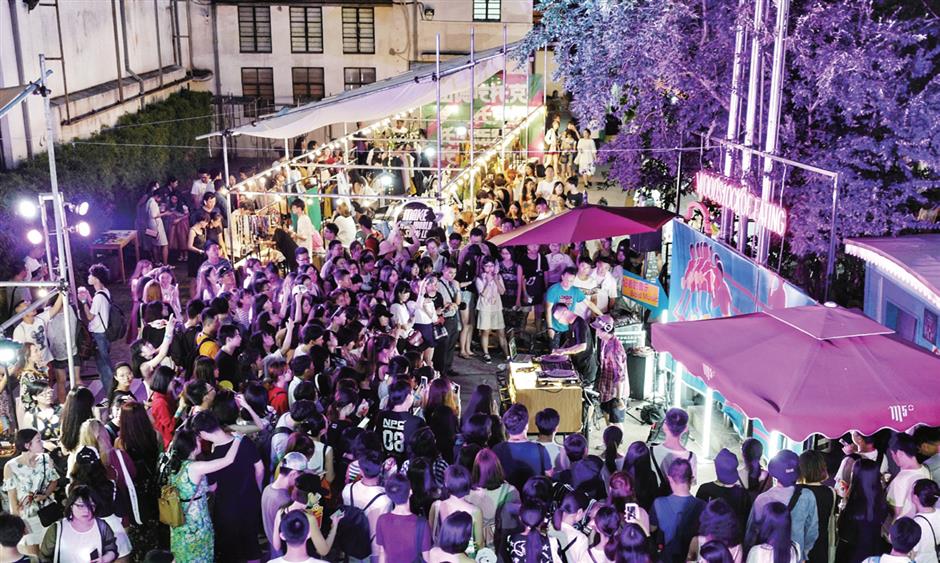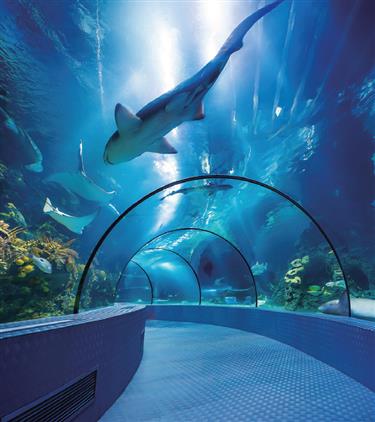Suzhou Creek festival's feast of culture, art

Young contestants show their music skills at the TikTok short video competition.
Over 100 exciting events take center stage at the annual Suzhou Creek Culture and Arts Festival in Putuo District.
An experience week along Suzhou Creek, a micro-tourism route promotion, mobile tourism markets and a short video competition on TikTok are just some of the many impressive activities available to the public at the month-long event, which kicked off September 22 and runs through October 16.
This year’s festival plans to showcase the many stimulating charms of Suzhou Creek.
Experience week
A “Suzhou Creek Experience Week” has been launched, inviting locals and visitors to stroll along the newly opened Suzhou Creek waterfront to see its many breath-taking attractions.
The week-long event features a series of happenings such as the illuminating terraces along the creek, traditional cuisines as well as visits to several cultural and entertainment sites.
The Putuo Culture and Tourism Bureau has appointed a group of reporters, painters and popular livestreaming hosts as “Suzhou Creek Waterfront Experience Officials” to help tourists enjoy their visit.
“Though I’ve traveled to over 1,000 places worldwide, Shanghai is always my favorite with new changes every day and more surprises for me to discover,” said popular travel livestream host Yin Jun, one of the newly appointed experience officials.
The officials, along with over 60 residents, walked along the waterfront through three newly unveiled routes which cover its innovation parks renovated from former industrial sites, many listed intangible heritage skills as well as authentic local cuisines.
The walking routes included the M50 art park, Changfeng Park, Suning Art Museum and Lego Center. The Lego Center invites young customers to construct innovative creations and exhibit them online and at the center.
Changfeng Ocean Park has launched an ocean environmental protection campaign, where customers can adopt and raise a marine animal and interact with them through the Internet.
A continuous path has been developed along the 21-kilometer section of the creek by demolishing obstacles and improving the riverside’s ecological environment.

A night market attracts throngs of visitors to experience the colorful life in Putuo during the Suzhou Creek Culture and Arts Festival.
The downtown section of Putuo creek was once home to some of China’s earliest industries. The waterfront section known as Baocheng Bay, for instance, was home to a fifth of China’s earliest textile factories, dating back to the 1920s. After 1949, the Shanghai No. 1, 6 and 7 cotton factories were based on the waterfront, along with a military warehouse for quilts and uniforms. The site was dubbed the “cradle of China’s textile industry.”
Several industrial buildings have been preserved, including a warehouse and pump house at 652 Changshou Road, which was built in 1922 by the Japanese Home and Foreign Cotton Trading Co and later owned by Shanghai Textile Holding Co.
M50 (50 Moganshan Road), a trendy contemporary art zone, has demolished walls to open its waterfront to the public. The park will host a children’s art innovation competition during the festival. Juniors from both home and abroad can showcase their innovative ideas and art talent, while a fund collected from the events will be donated to support children’s art education in China’s remote mountainous regions.
Since the M50 was created at the turn of the millennium, over 150 galleries and art institutes have chosen it as their home. The park is one of the first and most notable cases of industrial heritage being given new lease of life as a cultural agglomeration. The site, covering 24,000 square meters along Suzhou Creek, contains 50 buildings that were once home to the New China Textile Co, an iconic enterprise of the city’s industrial development. It is one of the best-preserved industrial sites downtown.
New street art on walls, corridors, street corners and parking spaces have been created across the park to reignite an enthusiasm for the location and bring public attention to the site’s history.
Its nearby “1,000 Trees” project, which will open to the public soon, has involved a waterfront redevelopment. Four of China’s earliest private flour factories, which opened in 1900, have been preserved as a museum, art gallery and restaurant.
An 80-year-old military warehouse has been transformed into a creative space for local startups, while a former watchtower has been retained for visitors to view the creek scenery.

Putuo’s Changfeng Park remains a popular tourist spot for many locals.
TikTok competition
Waterfront visitors are invited to take part in a short TikTok video competition. The event themed “My Comfortable Life, My Decision” runs through October 16 and invites the nation’s tourists to participate. The best videos will be posted on the official WeChat account of the Shanghai Morning Post and on TikTok where viewers can choose their favorite.
A micro-tourism campaign has been launched along with waterfront tours.
“Travel has become a fashionable lifestyle without the need of detailed planning, long trips or piles of luggage,” the organizer of the event said. “Citizens are encouraged to learn history and feel the warmth of the city through the designated tour routes.”
The routes themed on “Suzhou Creek Cultures,” “Red Stories (about the history of the Communist Party of China)” and “Reading architecture” allow participants to explore the city’s cultural heritage.
The first route starts from Mengqingyuan Park — a riverside park promoting environmental protection concepts — and goes through the historical Yichang Road Fire Brigade dating back to 1932, the Suzhou Creek Industrial Civilization Exhibition Hall, the privately-owned Suning Art Museum and the Museum of Mergers and Acquisitions and the Posters Museum. The route allows visitors to learn about the city’s former prosperity and glory through its historical structures.

Youngsters show great interest in an art workshop.
Another sightseeing route includes Changshou Park, the Huxi Revolutionary Exhibition Hall, the Shanghai Mint Co, Gu Zhenghong Memorial Hall and Shanghai Textiles Museum. Gu (1905-1925) was a pioneering local worker and a martyr who died in a massacre in a local workers’ strike in 1925.
The riverside region was the gathering place of industrial workers and the original site for the workers’ revolutionary campaigns.
Another route covers the Jade Buddha Temple, Shanghai Yuan Dynasty Water Gate Museum, the museum of the Caoyang Community, Zhenru Temple and Zhenru mutton restaurant.
Zhenru was originally formed around 1208 and 1224 during the Song Dynasty (960-1279). A monk named Yong’an developed the Zhenru Temple and built a Xianghua (or Scented Flower) Bridge, which brought worshippers to the area, according to one of the paintings.
Markets were later developed around the temple, which became prosperous after a large number of believers came to burn scents. The temple was rebuilt and expanded during the Yuan Dynasty (1279-1368).
To attract more citizens and visitors, the district’s tourism bureau has dispatched three vehicles to Putuo’s major shopping destinations, such as Global Harbor Mall. The vehicles pick up visitors and take them on tourism routes where they can learn various traditional skills or take part in handicraft workshops.
A night market near the Baocheng Bridge and the X Tower features artworks, miniature plants, toys, books and clothes.
‘Suzhou Creek Study’
A “Suzhou Creek Study” project has been established to encourage residents to read and offer a number of reading spaces and services.
The Putuo government wants to create a cultural platform for residents to read books, listen to lectures and enjoy traditional operas at community libraries along the creek.
The district has invited Liu Chan, a noted painter and the daughter of renowned painter Liu Haisu (1896-1994), to give a lecture on painting and her father, while leading Peking and Kunqu opera performers have given speeches online.
In recent years, Putuo has strengthened public cultural services, by building community facilities and branding protected cultural heritage.
The Haishang Seal Engraver’s Society, at Putuo District Culture Museum, has launched an exhibition with nearly 200 paintings and calligraphy works through November 1.
The Putuo brand of the Liu Haisu Art Museum offers an exhibition of paintings, calligraphy and seals from prestigious Haipai (or Shanghai-style)painters, including Zhang Daqian, Xu Beihong, Ma Gongyu, Tang Yun and Cheng Shifa. Over 100 artworks from the masters will be exhibited through October 8.
The festival plans seal carving, paper stick painting, shadow play, traditional Chinese instruments and Chinese opera performances. Two seal-engraving centers have been established at Zichang Middle School and No. 4 Middle School Affiliated with East China Normal University, while a reciting competition will be held on October 8 in Changzheng Town.

A truck promoting nightlife spots along the Suzhou Creek shuttles in the district during the annual tourism festival.
As part of Shanghai International Arts Festival, Suzhou Creek Culture and Arts Festival has become a popular attraction in the city and the Yangtze River Delta region.
The festival has been held for 13 consecutive years in Putuo and become a characteristic brand of the district’s public culture, attracting over 500,000 participants a year on average.
The city government plans to redevelop the waterfront further with continuous paths and attractions. The 125-kilometer creek, which flows from Qingpu District to Waibaidu Bridge, is Huangpu River’s biggest tributary. Unmanned supermarkets, vending machines and toilets will be dotted along the continuous paths in future as well as gardens and pocket parks.
Sidewalks, stretching 45 kilometers on the banks of the downtown part of the Huangpu River between Yangpu and Xupu bridges, are already open. The city plans to extend those both upstream and downstream, while improving services and scenery on existing sections.
The development plan is “Striving for a World-Class Waterfront Area,” and continuous riverside zones along both the Huangpu River and Suzhou Creek by 2020 will feature more greenery, preserved historical buildings, cross-river bridges, “sponge city” technology and “harmonious hues.”

Children have a fun time at Lego Center.

Changfeng Ocean Park

















